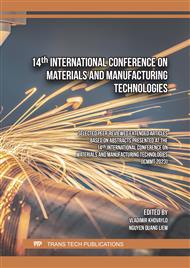p.3
p.11
p.17
p.25
p.33
p.41
p.51
p.63
Multi Objective Parametric Optimization of Ultrasonic Vibration Assisted Turning on TI6AL4V Alloy
Abstract:
The industrial and engineering applications of Titanium alloys has increased in the recent times particularly in automobile and aerospace industries. Ultrasonic machining of titanium alloys is one of the developments in the recent times to counter the poor machinability characteristics of Ti alloys. In this work, ultrasonic vibration assisted turning is adopted in machining Ti6AL4V with cutting speed, feed rate, depth of cut and amplitude as process parameters. Cutting force, cutting temperature and surface roughness are considered as performance evaluators. The role of each process parameter on each of the responses is evaluated and the optimum parametric combination for multi objective optimization is determined using Grey Relational Analysis. The results are interpreted with respect to tool work contact ratio. It was concluded from the experimental analysis that cutting force, cutting temperature and surface roughness depend on the TWCR which in turn depends on cutting speed and amplitude of vibration. Low TWCR revealed better performance whereas the effect of ultrasonic vibration is found to be reduced with increment in TWCR. In addition, feed rate and depth of cut are found to be significant in effecting the multi response characteristic (GRG).
Info:
Periodical:
Pages:
11-16
Citation:
Online since:
September 2023
Keywords:
Price:
Сopyright:
© 2023 Trans Tech Publications Ltd. All Rights Reserved
Share:
Citation:



